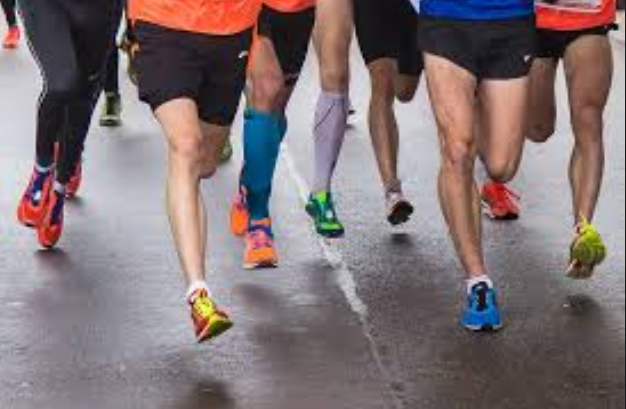It is Rewind Friday:
Chef and general overall badass Anthony Bourdain's gait.
A unique variation on the Circumducting Gait. You will see this one is many people, if you look for it.
https://thegaitguys.tumblr.com/post/21713480315/the-chef-another-abnormal-gait-pattern-in
The Chef: Another abnormal gait pattern in celebrity chef and The Travel Channel’s Anthony Bourdain.
It was just a few nights ago after a 13hour day with patients that I got home and climbed into bed, looking forward to flipping through channels to find something to alter my brainwave state. I needed to find something that would allow me to dial down into a slumber. Much to my happiness I found one of my favorite shows, “No Reservations” with my favorite chef. I get a real kick out of Tony. This is one smart dude. He is pretty slick with the english language. Did you ever get to read his New
York Times best seller “Kitchen Confidential”? What a killer book. We recommend the audio book read by the author himself. It turned the restaurant scene upside down. Has anyone ever told you not to order fish Monday through Thursday ? It is all in the book. Why else do I love Bourdain? His command of the english language is exceptional, and creative. For example, he once said, “what would it be like to be a meat-filled Pinata at a Pit Bull convention?”. Things like that stick with you.
Anyhow, so there I am lying in bed dozing off, listening to Bourdain talk about Mozambique and there he is in all his slender glory walking down the street with his sidekick Samir. “Red Alert, Red Alert ! " The clinical brain snaps back on. Dammit ! Knowing very well I had to rewind the cable box to see it again, but knowing I was slowly descending into deeper brainwaves, I quickly rewind and grab my iphone to record the gait you see above. You see, when you are a gait nerd like us, nothing escapes you when it is this obviously wrong. It is a disease; trust us. We cannot go anywhere anymore without noticing pathologic gait. It appears we cannot even watch a cooking show. And since we live on a planet where everyone walks, it must be a penance for something we must have done in another life.
Onto Bourdain’s gait.
Look at Tony’s circumducting feet compared to Samirs (on the right). Samir clearly engages pelvis lift on the swing leg side which is typically brought on by engagement of the hip abductors (g. medius) on the stance leg side. This lift on the swing side allows the swing leg to have ample room to pendulum through without having to prostitute the knee or foot posturing. The knee and foot simply sagittally hinge through, this is economical gait.
Bourdain on the other hand shows little if any swing side pelvis lift driven by stance leg hip gluteus medius engagement. This creates a clearance problem for the pendulum swing leg. So now the problem becomes how to get the leg to swing through without catching the toes and foot. You must create clearance. Clearance can be obtained by:
generating oppositehip abduction forcing the swing leg hemi-pelvis to lift
increasing hip flexion which will initiate a steppage gait. This will be combined with increased knee flexion. This is productive and necessary if you are climbing stairs or trying to unload a painful turf toe near the end of stance phase push off. When seen in normal walking gait it may represent neurologic pathology. But folks with hip problems or weakness will use it to get around to avoid tripping.
circumduct the swing leg hip. The act of swinging the leg outward and around will eat up the leg length.
circumduct the foot.
Bourdain is doing #4. It is a pretty lazy gait strategy, you can see it is lazy. It probably requires very little energy to flip the foot outside the normal ankle dorsiflexion foot swing progression. What must be the cost to activating the peronei and the lateral toe extensors to flip that foot around like that ? Sure you can see that the knees are for a moment carried outside the sagittal plane but who cares, right ?
There are a couple of concerns. One is that failure on a single step to generate sufficient foot/ankle circumduction will result in a foot catch and a fall. Another is the trouble in always getting that circumducting foot to land precisely in the near sagittal plane. When you move the foot on an arc you really only have a narrow target to land the foot within the 5-15degree landing zone. Circumduct too far and the foot is in-toed and more rigid due to it being supinated during midstance, circumduct too little and the foot is more out-toed and increased pronation risk increases. This goes for running as well.
Go back and watch Samir’s walk. Clean and done right, the swing leg is a passive pendulum. Tony’s is obviously different. Who knows, maybe he has bad hips ? Maybe it was always a struggle to walk normally. He is 6'4” so we cannot blame it on excessive height unless he lives in a house that has 6 foot ceilings, because then his strategy would be our gait of choice. It would be the only one that would effectively work ! Maybe that is it. Maybe he lives in Smallville ?
We don’t think so. The only for sure way to know would be to get him on our exam table and see what parts he is not using. We would put big money on weak gluteus medius, bilaterally. It is the one we see most often in this abnormal gait pattern.
Shawn and Ivo, tortured gait observers in a world of ambulatory pathology.
Welcome to our hell.






















